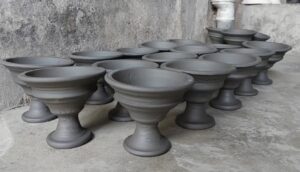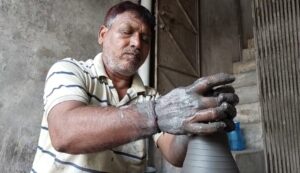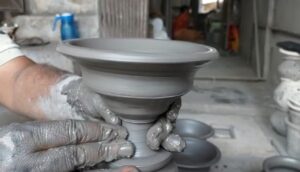The night nights of revelry are round the corner. Riot of colours will be seen on the grounds as the enthusiasts will be best dressed in their ethnic attire. Embroidered ghaghra- cholis, dupattas glittering with mirror work and other interesting props will be adorned by the khelaiyyas. They will sway on the beats of Garba until their feet tire.
We have always known Navaratri as the festival of celebrating the nine days by playing Garba, fasting, eating wholesome cuisine, and many other things. However, only a few would be aware that a ritual is practiced for bringing the Garba home.
The Origin
 Garba is a derivative of the Sanskrit word ‘garbha’, which means womb. It is performed in Gujarat to signal a girl’s first menstrual cycle and, subsequently, her impending marriage. Men occasionally take part in Garba as well (though Vadodara has Harsiddhi Garba of Amba Mata ni Pol where only men play Garba), but women typically perform it.
Garba is a derivative of the Sanskrit word ‘garbha’, which means womb. It is performed in Gujarat to signal a girl’s first menstrual cycle and, subsequently, her impending marriage. Men occasionally take part in Garba as well (though Vadodara has Harsiddhi Garba of Amba Mata ni Pol where only men play Garba), but women typically perform it.
The dance starts off softly and picks up speed gradually. During Garba, the performers create a circle around a clay pot known as ‘garbo’.
Kumbharwada’s Legacy
Stepping into the lane of Kumbharwada, you will surely be petrichored. While we are counting days for Navaratri, special clay pots; garbo is being made in this area of the city. Devotees of Mataji will install this garbo in their houses for 10 days. “It’s been two months now that we have started making garbo, we have been doing this for over generations,” informs Hasmukhbhai Prajapati, Shop Owner at Kumbharwada.

He further enlightens us by terming his work as “hereditary business”. It’s been over 150 years of Gaekwad’s rule. “Our forefathers were living here and today we continue to live and make earthenware and garbo,” tells Prajapati. To make the garbo, soil (clay) is mandatorily brought from the lake and filtered. While the one brought from the field is used to make cups and saucers. “We prefer bringing soil from Than- Chotila to make garbo,” states Prajapati.
A lot depends on the weather conditions when these clay pots are being made. “If the atmosphere is dry and clean, about 60 to 70 garbo are made in a day. But if there is rain, then only 30-40 pieces are possible,” conveys Prajapati. The whole family comes together to make garbo out of mud. They do wholesale business of the same, wherein the clay pots made by them are sent to all places in Vadodara. Moreover, these masterpieces are also sent to Surat, Mumbai, Bharuch, Ankleshwar and Ahmedabad. The price varies according to the size of the garbo, though currently the price starts from 50 rupees. “The traders take it and sell it for 200-300 rupees,” says Prajapati. Imagine the huge profit margin!
 One of the outstanding features of garbo is, the holes or intricate patterns made in it. Mataji‘s Deep (lamp) known as Garbha Deep is then placed in the garbo. The metaphorical interpretation of Garbha Deep exists. The vessel itself is a representation of the body, wherein the Goddess-like form of divinity lives. To honour the truth that every individual possesses the divine spirit of Devi within them, Garba is performed around this. In order to spread the light and positivity of that lamp throughout the house, the holes and patterns are made in the pot at equi- distant. So are we all set to invite our Maavadi?
One of the outstanding features of garbo is, the holes or intricate patterns made in it. Mataji‘s Deep (lamp) known as Garbha Deep is then placed in the garbo. The metaphorical interpretation of Garbha Deep exists. The vessel itself is a representation of the body, wherein the Goddess-like form of divinity lives. To honour the truth that every individual possesses the divine spirit of Devi within them, Garba is performed around this. In order to spread the light and positivity of that lamp throughout the house, the holes and patterns are made in the pot at equi- distant. So are we all set to invite our Maavadi?
કુમકુમ કેરા પગલે માડી ગરબે રમવા આવ,
કે માડી ઘણી ખમ્મા..ખમ્મા..ખમ્મા!

















